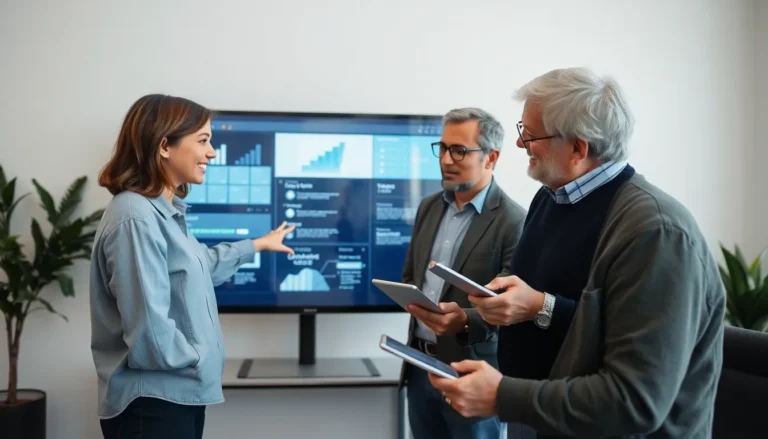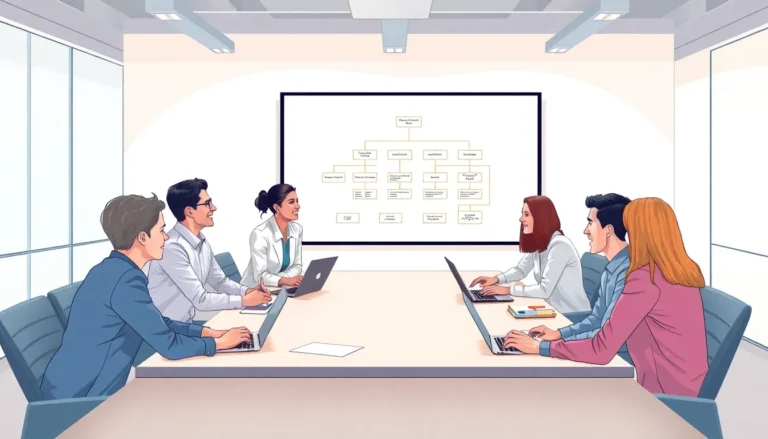Table of Contents
ToggleIn the world of business, procurement often feels like the unsung hero, quietly keeping the wheels turning while everyone else basks in the spotlight. But let’s face it—without a solid procurement organization structure, chaos could reign supreme. Imagine a team of cats trying to organize a dog show. Not pretty, right?
Crafting an effective procurement structure isn’t just about filling roles; it’s about creating a well-oiled machine that drives efficiency and cost savings. From strategic sourcing to supplier management, the right setup can transform procurement from a back-office function into a powerhouse of value creation. So, buckle up as we dive into the nuts and bolts of procurement organization structures that can help businesses thrive in today’s competitive marketplace.
Overview of Procurement Organization Structure
Procurement organization structure defines how procurement functions are organized within a business. A clear structure ensures effective communication and streamlined processes.
Definition of Procurement Organization Structure
A procurement organization structure outlines roles, responsibilities, and relationships within the procurement team. This framework can vary by business size and industry, encompassing various models such as centralized, decentralized, and hybrid structures. Centralized structures consolidate decision-making, while decentralized models empower local teams. Hybrid structures combine both, tailored to specific needs.
Importance of an Effective Structure
An effective procurement structure drives operational efficiency and cost savings. It enhances collaboration between departments, leading to better supplier relationships and strategic sourcing. Clear hierarchies support faster decision-making and improved accountability. Establishing a robust procurement framework positions businesses to respond swiftly to market changes and competitive pressures, ultimately contributing to sustainable growth.
Key Components of Procurement Organization Structure

An effective procurement organization structure consists of various key components that enhance overall performance. Understanding centralized and decentralized models plays a significant role in shaping procurement strategies.
Centralized vs. Decentralized Models
Centralized procurement consolidates purchasing activities under one team, promoting consistency in decision-making. This model often results in negotiated discounts due to bulk purchases. It also encourages unified strategies across departments. Conversely, decentralized procurement allows individual departments greater autonomy, fostering tailored purchasing decisions that align with specific needs. This flexibility can enhance responsiveness to local market conditions. Each model offers distinct advantages and drawbacks, influencing the procurement process’s effectiveness within various business contexts.
Roles and Responsibilities within Procurement
Clearly defined roles and responsibilities are critical for a well-functioning procurement team. Procurement managers oversee the entire procurement process, ensuring alignment with business objectives. Buyers execute purchase orders and manage supplier relationships, maintaining effective communications throughout. Analysts assess market trends and supplier performance, contributing valuable insights. Additionally, compliance officers ensure that procurement practices adhere to legal and ethical standards. Each role supports the organization’s goals, streamlining operations and enhancing strategic sourcing initiatives.
Best Practices for Designing Procurement Organization Structure
Designing a procurement organization structure requires strategic alignment with business goals. Effective aligning ensures procurement efforts directly support overall organizational objectives, enhancing operational efficiency.
Aligning Structure with Business Goals
Establishing clear connections between procurement and business strategy drives value. Individual departments must align their procurement processes with the company’s strategic priorities. Procurement leaders should assess how each element of the structure supports initiatives like cost reduction, supplier collaboration, or risk management. Identifying key performance indicators helps measure alignment and effectiveness. Regular evaluations of procurement goals against business developments maintain relevance and responsiveness. Each procurement role contributes uniquely to fulfilling company needs, ensuring a cohesive approach throughout the organization.
Utilizing Technology in Procurement
Incorporating technology in procurement enhances efficiency and data-driven decision-making. Implementing procurement software streamlines processes like sourcing, contract management, and supplier evaluation. Cloud-based platforms increase accessibility and collaboration across teams and departments. Analytics tools provide valuable insights into spending patterns, enabling better strategic sourcing. Electronic procurement systems reduce manual errors, improving accuracy and compliance. Continuous training on new technologies fosters innovation within procurement teams, ensuring they adapt to changing market conditions effectively. Prioritizing technology in procurement positions organizations to capitalize on emerging opportunities.
Challenges in Procurement Organization Structure
Procurement organizations often face numerous challenges that hinder efficiency and effectiveness. Addressing these challenges requires an understanding of potential pitfalls and the development of strategic solutions.
Common Pitfalls to Avoid
Ignoring communication barriers can lead to misunderstandings within the procurement team. Disjointed roles often result in duplicated efforts or overlooked responsibilities. Failing to align procurement strategies with overall business objectives can diminish value creation. Over-reliance on legacy systems restricts modernization and adaptation to market changes. Neglecting supplier relationships may create missed opportunities for collaboration and innovation. These pitfalls impede the procurement process and restrict an organization’s ability to respond effectively to evolving demands.
Strategies for Overcoming Challenges
Implementing regular training fosters skill development and enhances team capabilities. Establishing clear communication channels streamlines information flow and reduces confusion. Aligning procurement practices with business goals ensures consistency in decision-making and resource allocation. Investing in modern technology supports data-driven insights and improves operational efficiency. Encouraging collaboration across departments enables tailored solutions that meet unique needs. These strategies enhance the procurement organization’s structure, empowering teams to navigate challenges confidently and effectively.
A well-defined procurement organization structure is vital for businesses aiming to thrive in a competitive landscape. By establishing clear roles and responsibilities, organizations can streamline operations and enhance collaboration across departments.
Choosing the right model—centralized, decentralized, or hybrid—can significantly impact procurement efficiency and effectiveness. Adopting best practices and leveraging technology not only fosters innovation but also positions procurement teams to tackle challenges head-on.
Ultimately, a strategic approach to procurement structure not only drives cost savings but also strengthens supplier relationships, paving the way for sustainable growth and long-term success.







